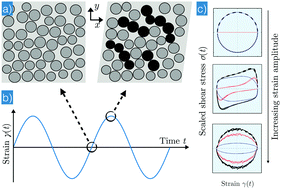Oscillatory rheology of dense, athermal suspensions of nearly hard spheres below the jamming point
Abstract
The viscosity of a dense suspension has contributions from hydrodynamics and particle interactions, both of which depend upon the flow-induced arrangement of particles into fragile structures. Here, we study the response of nearly hard sphere suspensions to oscillatory shear using simulations and experiments in the athermal, non-inertial limit. Three distinct regimes are observed as a function of the strain amplitude γ0. For γ0 < 10−1, initially non-contacting particles remain separated and the suspension behaves similarly to a Newtonian fluid, with the shear stress proportional to the strain rate, and the normal stresses close to zero. For γ0 > 101, the microstructure becomes well-established at the beginning of each shear cycle and the rheology is quasi-Newtonian: the shear stress varies with the rate, but flow-induced structures lead to non-zero normal stresses. At intermediate γ0, particle–particle contacts break and reform across entire oscillatory cycles, and we probe a non-linear regime that reveals the fragility of the material. Guided by these features, we further show that oscillatory shear may serve as a diagnostic tool to isolate specific stress contributions in dense suspensions, and more generally in those materials whose rheology has contributions with both hydrodynamic and non-hydrodynamic origin.



 Please wait while we load your content...
Please wait while we load your content...